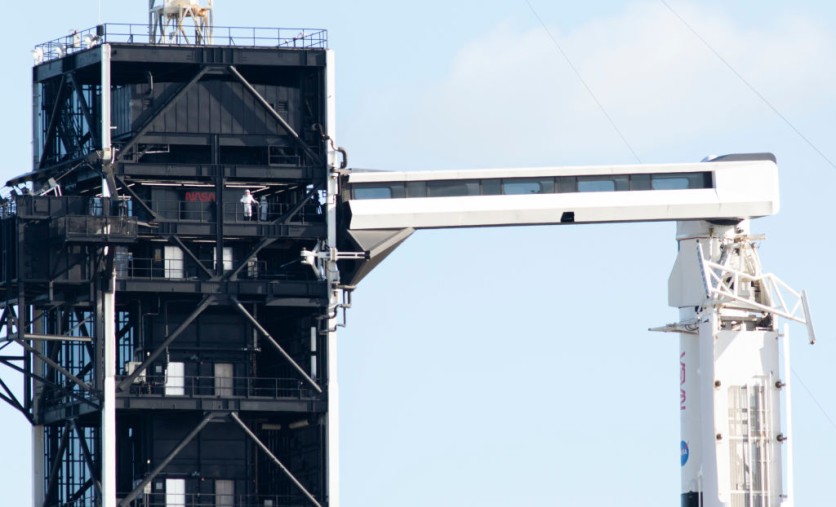The most recent NASA astronaut mission from SpaceX has finally reached its destination despite being delayed twice.
As reported first by Space.com, the Crew-5 astronaut mission was launched from NASA's Kennedy Space in Florida, carrying a Dragon capsule on top of a Falcon 9 rocket, on Oct. 5.

(Photo : Joel Kowsky/NASA via Getty Images)
CAPE CANAVERAL, FLORIDA - OCTOBER 05: In this handout photo provided by NASA, NASA astronaut Josh Cassada, left, and Nicole Mann, are seen on the fixed service structure of Launch Complex 39A before boarding SpaceXs Crew Dragon spacecraft atop the companys Falcon 9 rocket before the launch of NASAs SpaceX Crew-5 mission to the International Space Station, at NASA's Kennedy Space Center on October 05, 2022 in Cape Canaveral, Florida.
Endurance Reaches the ISS
After a 29-hour orbital chase, the capsule, called Endurance, finally connected with the International Space Station (ISS) on Oct. 6.
While the two spacecraft were traveling over the Atlantic Ocean near the coast of West Africa, Endurance got in touch with the forward port of the Harmony module of the station. Ten minutes later, the docking process was finished, as per Space.com's report.
Around 6:45 p.m., the hatches between Endurance and the ISS opened, and the Crew-5 astronauts, which included NASA's Nicole Mann and Josh Cassada, Japan's Koichi Wakata, and cosmonaut Anna Kikina, transferred onto the orbiting lab about 10 minutes later. The astronauts will be spending five months on the ISS.
Crew-5 will be historic in numerous ways. For instance, Mann will make history as the first Native American woman to travel to space, while Kikina will make history as the first Russian to fly with SpaceX.
Mann and Kikina are both space rookies but Wakata, on the other hand, has already traveled to space five times.
SpaceX's Crew-3 mission was also transported to and from the ISS by the Dragon Endurance. Four Crew Dragon capsules, which are updated and put through testing before each subsequent flight, were utilized by SpaceX.
Brand-new Components
The components used by Endurance during flight were a brand-new heat shield, parachutes, and nose cone, as per Space.com.
Although SpaceX is renowned for launching old rockets, the Crew-5 launch used a Falcon 9 with a brand-new first stage. The rocket's booster, which was emblazoned with NASA's worm insignia, was sparkling white and clean of the soot that often covers the company's reflown first stages.
Seven crew members, including four from SpaceX's Crew-4 mission, are already on board the ISS when the Crew-5 astronauts arrived.
The countdown to Crew-4's departure from the station, which will occur in roughly a week, starts with the arrival of Crew-5, according to Sarah Walker, director for Dragon mission management at SpaceX.
Weather will determine exactly when Crew-4 will return to the surface off the coast of Florida, Walker said at the press conference held yesterday following the launch.
It is worth noting that the launch of Crew-5 was initially scheduled on Oct. 4, but Hurricane Ian delayed it by two days.
The Artemis 1 moon mission's schedule was far more significantly impacted by the storm. NASA had planned to launch the unmanned Artemis 1 on Sept. 27, but Ian prompted the team to bring the massive rocket back to the facility's Vehicle Assembly Building from Pad 39B at KSC.
The Artemis 1 launch is now scheduled for Nov. 12 to Nov. 27, according to NASA.
Related Article : SpaceX's Starlink Speed Slows Down Due to Satellite Congestion, Astronomers to Put a Stop to It?
This article is owned by Tech Times
Written by Joaquin Victor Tacla
![Apple Watch Series 10 [GPS 42mm]](https://d.techtimes.com/en/full/453899/apple-watch-series-10-gps-42mm.jpg?w=184&h=103&f=9fb3c2ea2db928c663d1d2eadbcb3e52)



